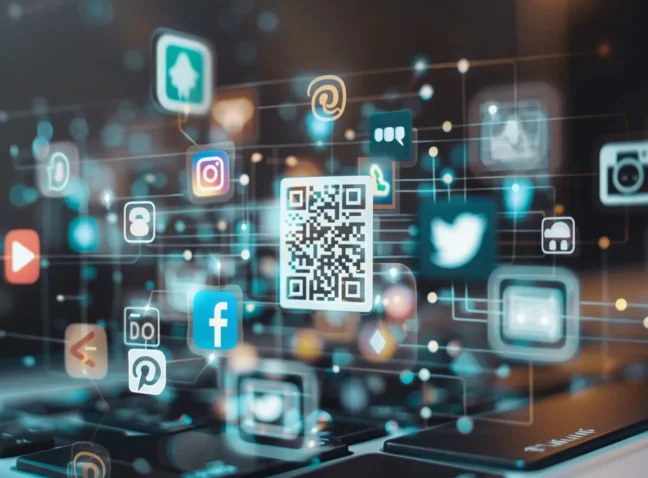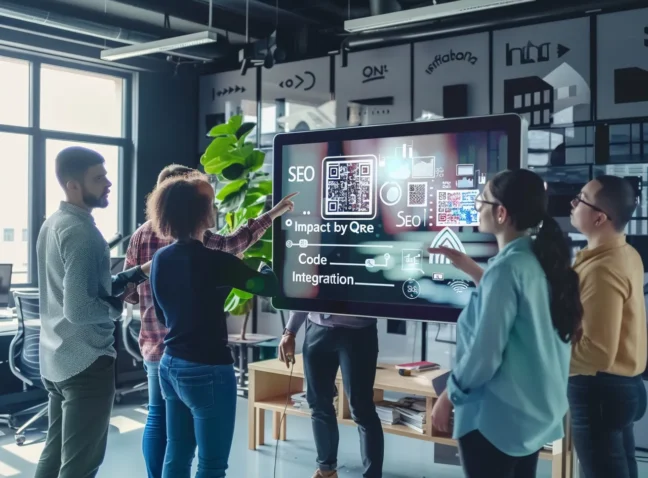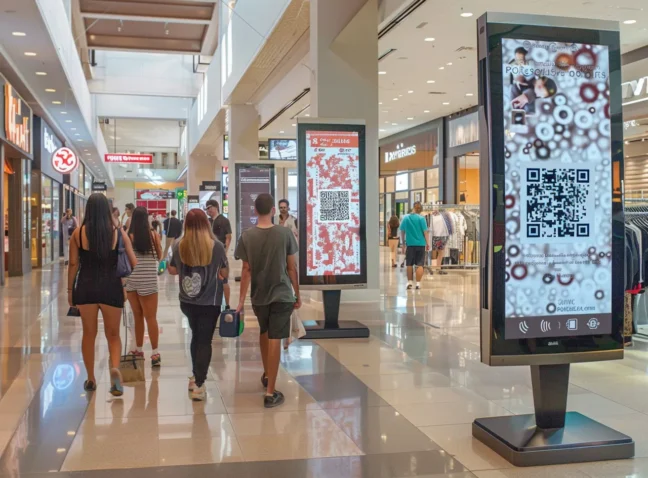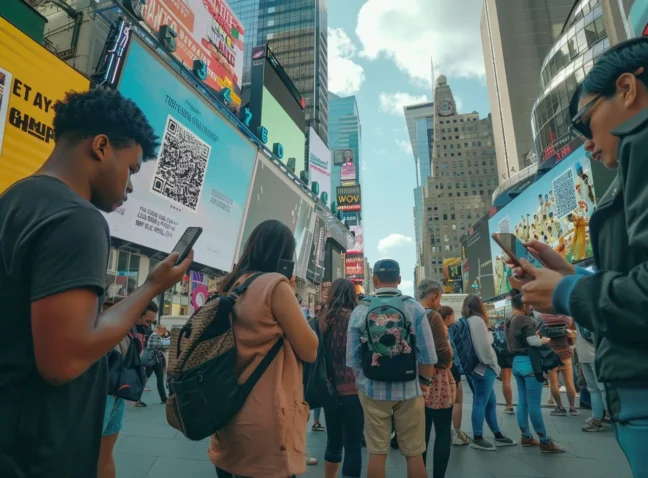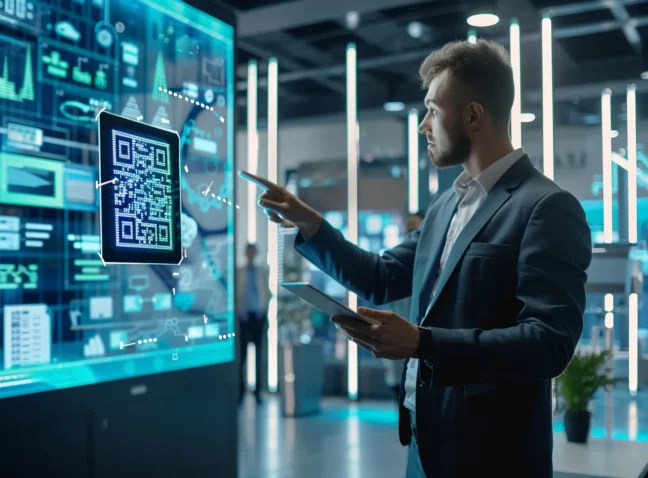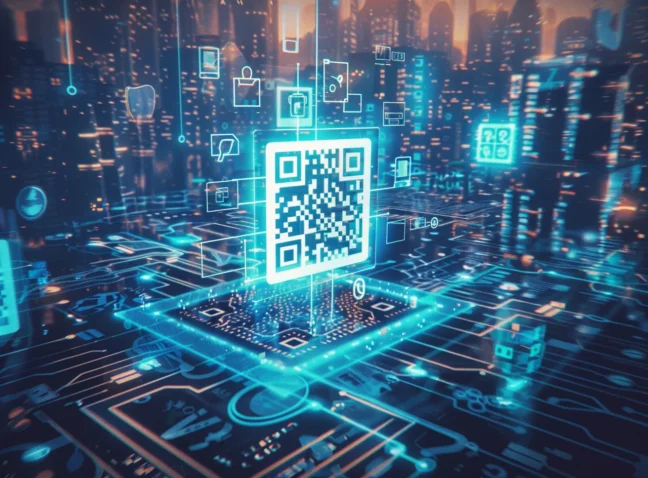The best QR code size for printing is 2×2 centimeters (0.8×0.8 inches) or bigger. However, this answer is not ultimate since the ideal dimensions depend on multiple factors. The choice relies heavily on your code’s purpose, target audience, and other specifics. Besides, the distance between the code and the scanning device is critical.
QR codes may serve various business and individual needs. The technology is highly beneficial for restaurants, marketing campaigns, inventory management, logistics, retail, and many other industries. On top of that, you may place your QR code on different objects, from a small brochure to a giant billboard. All these scenarios require specific approaches and technical considerations, and the ideal QR code size also varies.
Here’s a summary of the minimal QR code size requirements in different measurement systems:
| Size | Scanning distance (based on the 1:10 ratio) | |
| Centimeters | 2×2 cm | 20 cm |
| Millimeters | 20×20 mm | 200 mm |
| Inches | 0.8х0.8 in | 8 in |
| Pixels | 75.6 px | – |
Please note that even smaller QR codes might still be scannable (and even optimal for specific use cases). Also, the QR code size could be larger than specified in the table above, depending on your particular goals. This article will cover all the essentials regarding possible QR code sizes for various needs and the importance of choosing the correct dimensions. Also, we will explain how to generate a QR code of the right size with a reliable tool like MyQRCode.
Does QR Code Size Matter?
Yes, your QR code size matters greatly regarding scannability, accessibility, and effectiveness. With the appropriately chosen dimensions, your QR code will be readable via most types of mobile devices running various platforms, including iOS and Android. Besides, a QR code with the correct size will be easy to place wherever required, be it a restaurant menu, YouTube video, or business card.
Now, let’s discover why paying extra attention to a QR code’s size is vital.
- Scannability. The size of a QR code directly impacts its readability. Thus, making sure your code is easy to scan via a mobile device is crucial. For instance, QR codes on billboards should be big enough to remain scannable from a distance.
- Data storage capabilities. Your QR code size affects its ability to store the required amount of data. It’s critical when you link your QR code to website URLs, contact details, multimedia content, etc.
- Visibility. Ensure your QR code is noticeable to users. Even when scannable, small codes may fail to draw people’s attention, resulting in poor conversion.
- The quality of printing. The wrong QR code size may cause readability challenges if the quality of printing is insufficient.
- App specifics. When generating a QR code for a specific application, consider its size requirements. A code that is too big (or not big enough) may not be suitable for a particular app’s interface.
- User experience. User engagement and overall experience depend on the code’s size and design. If chosen correctly, they lead to optimal performance and satisfaction, increasing the number of scans.
All in all, the size of your QR code influences its efficiency. And, since this technology is one of the most result-driven and convenient tools in modern marketing and communication with the audience, it’s worth choosing your QR code’s size thoroughly.
But, as mentioned, the optimal QR code size usually depends on specific business goals and requirements. So, your particular use case is the most critical factor to consider when making your final decision.
The Best QR Code Sizes for Different Uses
The best QR code size varies in different use cases. Here’s a QR code size table summarizing the most widespread scenarios, considering that the optimal distance-to-scan ratio is 1:10.
| Proximity | QR code generator type | Best QR code size |
| Close proximity (restaurant menus, business cards, brochures, flyers, product packaging, etc.) | Basic QR code generator | 2 to 5 centimeters / 20 to 50 millimeters /0.8 to 2 inches /70 to 200 pixels |
| Medium-distance proximity (medium-sized billboards, presentations, banners, wall posters, product stands, TV commercials, etc.) | QR code generator with customization capabilities | 6 to 10 centimeters / 60 to 100 millimeters / 2.4 to 4 inches / 200 to 600 pixels |
| Long-distance proximity (large city billboards) | High-capacity QR code generator allowing for advanced customization | 10+ centimeters / 100+ millimeters / 4+ inches / 600+ pixels |
With that in mind, let’s dive deeper into the most suitable QR code size for various business uses.
Optimal Size for QR Codes Scanned in Close Proximity
The optimal size for QR codes scanned in close proximity ranges from 2 to 5 centimeters (0.8 to 2 inches). Such QR codes are perfect for small printed marketing materials. Besides, this QR code size suits restaurant menus, websites, emails, YouTube videos, and more. Let’s look at these QR code types in more detail.
Best QR Code Size for Printing
The best QR code size for printing is between 2 and 5 centimeters (approximately 0.8 and 2 inches) for flawless readability. It refers to QR codes placed on brochures, flyers, product packaging, and so on.
Considering your code’s viewing and scanning distance is also essential. When choosing the size for your printed QR code, pay attention to print resolution. This way, you will maintain clarity and prevent the potential loss of image quality. Also, ensure the design of your card, flyer, brochure, etc., matches the chosen QR code’s size. The white space (“quiet zone”) around your code should be at least 15% of its size to maximize its scannability.
Using QR codes in printed advertising is highly beneficial for modern businesses. In the US alone, nearly 89 million smartphone users scanned a QR code on their smartphones in 2022, which is 26% more than in 2020 (Statista, 2023). With the right design and perfect size for scanning, your code will bridge your physical ads and digital content, bringing more customers to your website, social media pages, or else.
Ideal QR Code Size for Business Cards
The ideal QR code size for a business card is 2 to 5 centimeters (0.8 to 2 inches). It balances the limited space on a physical business card and the optimal code’s scannability.
A 2×2 cm QR code fits business cards since it doesn’t dominate the space yet remains noticeable and readable. Moreover, with a robust QR code generator like MyQRCode, you can customize your code’s style and tailor it to your card’s design. In particular, changing the color palette, shape, frame, and pattern of your QR code is possible.
It’s worth noting that in today’s digital world, companies strive to provide more interactive and engaging experiences to the audience. People throw away nearly 88% of business cards, as per CreditDonkey, 2022. However, a dynamic QR code on the card may encourage users to visit your website or digital business page and learn more about your brand online.
Correct QR Code Size for Website or Email
The correct QR code size for a website or email is approximately 150×150 pixels, equal to about 4×4 centimeters and 1.5×1.5 inches. This size ensures your code’s sufficient visibility on the page without overwhelming the interface.
Another critical consideration when choosing the QR code size for a web page or email is its responsiveness. Nearly half of web traffic worldwide comes from mobile phone users (Statista, 2023). Therefore, ensuring that all the design elements fit all types of screens has become a rule of thumb for modern businesses. A 150×150-pixel QR code is convenient to scan via any device and platform, resulting in better user experience and increased satisfaction.
Best QR Code Size for Restaurant Menu
The best QR code size for a restaurant menu is approximately 3×3 centimeters (1.2×1.2 inches). This way, your code will be clearly visible on the menu without occupying too much space.
Please note that QR codes on restaurant menus are often slightly larger than on flyers, brochures, and product packaging. Thus, customers can instantly identify the code and quickly access the encoded information. At the same time, the space on a menu is usually limited. A QR code that is too big may create visual clutter and distract attention from the primary content. So, it’s worth choosing the size that will keep the right balance, depending on your menu’s size and design specifics.
When implemented correctly, a QR code for a restaurant menu enhances customer experience and streamlines the ordering process. Visitors spend 15 to 20% less time making orders via QR codes than with paper menus (New York Post, 2022).
Proper QR Code Size for YouTube and Other Videos
The proper QR code size for YouTube and other video content is about 4×4 centimeters (1.6×1.6 inches), which is nearly 113×113 pixels. Such a code is easy to scan, remaining visible on various screens without distracting viewers from the visuals displayed.
Please remember to communicate the role and value of a QR code clearly and convincingly. Explain where the code takes (for instance, to a web page, additional content, video-related promotional offer, etc.) The code’s size and design should meet your video’s specifics and remain on the screen for sufficient time, enabling viewers to notice and scan it.
Video remains one of the most effective marketing tools. Over 91% of businesses use YouTube and other video-sharing services to attract more customers (Wizowl, 2023). Combining it with a QR code is a result-driven way to retain viewers and drive traffic to your website, business page, or social media.
Optimal Size for QR Codes Scanned at Medium-Distance Proximity
The optimal size for a QR code scanned at medium-distance proximity is between 6 and 10 centimeters (3 to 4 inches). This size suits retail materials, presentations, and TV commercials.
Best QR Code Size for Retail
The best QR code size for retail purposes is 5 to 10 centimeters (2 to 4 inches). Let’s consider the most widespread types of such codes and their recommended sizes.
Optimal QR Code Size for Mid-Sized Billboards, Banners, and Product Stands
The optimal size of a QR code for mid-sized billboards, banners, and product stands is around 6 to 8 centimeters (2.5 to 3.1 inches). Codes of this size are easy to notice and scan from a moderate distance. At the same time, they leave enough space for other content, such as images, product details, and special offers.
Retail businesses usually need QR codes linked to digital content that contains various information, from product specifications and pricing to promotional videos. A 6-8-centimeter QR code has sufficient capacity to include any data you need. Besides, this size supports clear printing, which is important for the code’s readability from the required distance.
Placing suitable and quality QR codes on banners, billboards, and product stands is a promising practice for retail businesses. Your customers can easily access information about products, sales, and offers by scanning the code in or outside the store, point of sale, or elsewhere.
Recommended QR Code Size for Over-the-Counter Promos
The recommended QR code size for over-the-counter promos is approximately 5×5 centimeters (2×2 inches). This size strikes a balance between accessibility in close proximity and space for easy smartphone scans.
An over-the-counter promo is an engaging way to attract customers’ attention to special offers right in the store. A QR code makes this experience more interactive, allowing visitors to access information about promoted goods via their mobile devices. The code placed right in front of the shoppers’ eyes encourages their spontaneous participation in your promotions at the point of sale.
Best QR Code Size for Store Entrance
The best QR code size for a store entrance is approximately 10 centimeters (4 inches). Thanks to this larger size, your code becomes visible to customers coming to the store. A quick and convenient scan will provide instant access to special offers, promotions, loyalty programs, and other information.
Please note that a QR code smaller than 10 centimeters (4 inches) may fail to deliver the same value. Scanning from a distance will be more challenging, and the QR will be less noticeable to your customers. In contrast, a large QR code provides an effortless scanning experience for busy visitors entering your store.
One great example of using a QR code at store entrance is Decathlon’s Scan and Go application. When scanning a QR code placed at the store, customers can have their products delivered to their doorstep (MishiPay, 2019). This way, the store improves buyers’ experience, enhancing their trust and satisfaction.
Suitable QR Code Size for Presentations and Speeches
The most suitable QR code size for presentations and speeches during conferences or special events is approximately 6 centimeters (2.4 inches). This size ensures meeting attendees can swiftly scan the code to access additional information or resources.
Before using the QR code in your presentation for a special event, conference, or lecture, make sure it fits the design of your presentation slides. Besides, try to customize and align the code with the overall presentation format. Also, consider using a compelling call-to-action (CTA) to introduce the code’s purpose. Your event’s visitors will be more likely to scan the code if they understand its purpose and value.
Correct QR Code Size for TV Commercials
The correct QR code size for TV commercials is about 8×8 centimeters (3.1×3.1 inches). It ensures adequate visibility on any TV screen and provides enough space for viewers to scan the code. At the same time, other visual elements of the commercial remain prominent.
TV commercials usually represent a specific visual flow. A QR code integrated into such content should be easy to identify. With the MyQRCode generator, you can tailor your code’s design to the commercial’s specifics. For instance, adding a frame to a QR code is a good idea, making it stand out from other content while matching other on-screen elements. Another critical consideration is the code’s display time duration. Make your QR code visible long enough, letting customers notice and scan it effortlessly.
A QR code adequately used in a TV commercial will attract more visitors to your website, product page, or any other digital content. A recent study found that 95% of customers know how to scan a QR code, and almost half of them are ready to learn more about advertised products via their smartphones (LoopMe, 2023).
Ideal Size for QR Codes Scanned at Large Distance
The ideal size for QR codes scanned at large distances is 10 centimeters (6 inches) and beyond. Big QR codes are suitable for different types of city billboards.
Perfect QR Code Size for Billboards
The perfect QR code size for billboards varies from 8 to 15 centimeters (3.1 to 5.9 inches), depending on the billboard’s type, size, and the required scanning distance. Here are the optimal QR code sizes for the most common billboard types.
Appropriate QR code size for static city billboards
The appropriate QR code size for static city billboards is 12 to 15 centimeters (4.7 to 5.9 inches) or beyond, depending on the billboard’s size and location. The general guideline here is to rely on the scanning distance. Simply put, the farther your billboard is from people on the street, the larger your code should be. Most importantly, make sure people can easily scan the code while walking or driving nearby.
Providing high contrast between the code and background is also essential to facilitate scanning. It’s a good idea to test the code and verify its scannability from different angles before placing it on the static city billboard.
Correct QR code size for digital billboards
The correct QR code size for a digital billboard is approximately 10×10 centimeters (3.9×3.9 inches). Digital billboards are dynamic and have shorter viewing times. A slightly smaller size implemented in this advertisement type contributes to rapid comprehension and scanning.
Also, please note that the QR code on digital billboards is part of a concise message delivered to potential customers. With that in mind, verify whether your code’s size, design, and location fit this idea well.
Recommended QR code size for transit advertising billboards
The recommended QR code size for transit advertising billboards (for example, placed on buses or train stations) is 8 to 10 centimeters (3.1 to 4 inches). Considering the limited time available for scanning, this size ensures visibility for commuters.
Please remember that this type of advertising targets a moving and busy audience. So, ensuring the code’s maximized visibility and good contrast with the background is crucial.
Factors that Influence QR Code Size
The factors that most critically influence the ideal QR code size include the code’s shape and error correction. Let’s take a closer look at each of them.
How the Shape of a QR Code Influences Its Size
The QR code’s shape directly impacts its size in terms of functionality, scanning distance, and visual integration. Here’s how the shape of different QR codes – square, rectangular, and circle – impacts their appropriate sizes.
- Square QR codes. Square is the most common shape for QR codes. They are the most versatile in scanning, allowing for any size, depending on your individual needs. For instance, a small square QR code is perfect for close-range scenarios. It suits business cards, product packaging, and restaurant menus. In contrast, large square QR codes are ideal for scanning from a distance. You can use them for store entrances, city billboards, and more.
- Rectangular QR codes. This QR code shape is less widespread than square ones. The most famous example of its implementation is rMQR (Rectangular Micro QR Code). Such codes are suitable for specific use cases when the code needs to fit small elongated objects, like product labels on packaging. Also, the scanning angle and distance impact such codes more.
- Circle QR codes. The circle shape is rather uncommon for QR codes. Circle codes shouldn’t be too large since the square shape doesn’t maximize scannability from any angle and distance. Consider using a circle QR code for unique print and marketing materials to highlight distinct designs and the brand’s creativity.
The shape of a QR code can be different depending on your goals and implementation scenarios. However, the square shape is the most flexible solution for various QR code sizes and scanning distances.
The Influence of Error Correction on QR Code Size
The QR code’s error correction level influences its size since this feature is critical regarding the code’s data capacity. Error correction makes QR codes functional even if their parts are damaged or blurred. Larger codes allow for a higher error correction level. In turn, more compact ones support a lower level of correction.
What Is the Best Size of QR Code with the Highest Level of Error Correction?
The larger size (5 centimeters or 10 inches and beyond) is best for a QR code with the highest correction level, like Level H. Such codes are more damage-resistant due to printing imperfections, wear, or weather conditions. This error correction level requires a bigger QR code size. Thus, you can adopt sufficient space for greater data redundancy. Large codes with higher error correction are perfect for enhanced reliability and endurance.
What Is the Best Size of QR Code with the Lowest Level of Error Correction?
The best size for QR codes with the lowest error correction level, such as Level L, is more compact (approximately 2 centimeters or 0.8 inches). Lower error correction levels and smaller sizes are suitable when your code isn’t likely to experience any damage, wear, or distortion. At the same, the basic error correction capabilities will still be in place. Such codes are perfect for compact print materials and other objects, like business cards and product labels.
Best Size for Different Types of Two-Dimensional Barcodes
The best size for different two-dimensional barcode types, such as mQR, Aztec code, Data Matrix code, etc., varies from 1×1 centimeters (0.4×0.4 inches) to 5×5 centimeters (2×2 inches). The most appropriate dimensions depend on the particular barcode type’s specifics, including available space, data capacity, and implementation requirements.
Here are the optimal sizes for the most widespread two-dimensional barcode types, apart from standard QR codes:
- mQR (Micro QR Code). The best micro QR code size is around 1×1 centimeters (0.4×0.4 inches). It’s compact enough to fit the limited space you can place your mQR on (for instance, small product labels).
- Aztec code. The most suitable size for an Aztec code is nearly 2×2 centimeters (0.8×0.8 inches). It balances optimal readability and space efficiency, ensuring versatility for different uses, such as airline tickets or car registration documents.
- Data matrix code. The ideal size for a data matrix code is around 2×2 centimeters (0.8×0.8 inches). Considering these dimensions accommodate critical data encoding, they suit various use cases like manufacturing and logistics.
- PDF-417 barcode. The best size for PDF-417 barcodes is approximately 4×2 centimeters. While remaining perfectly readable, such a code fits identification cards, boarding passes, and other uses.
- MaxiCode. The perfect size for MaxiCode is around 5×5 centimeters (2×2 inches). This larger size is optimal for capturing the intricate hexagonal pattern, which suits shipping labels in logistics.
- rMQR (Rectangular Micro QR Code). The appropriate size for rMQR codes is around 1.5×1 centimeters (0.6×0.4 inches). This size fits narrow spaces required for equipment inventory in medical and pharmaceutical fields.
Please note that alternative types of two-dimensional barcodes are less versatile than QR codes. In particular, they usually suit specific industries and use cases. Meanwhile, QR codes have many possible implementations, from small printing materials to giant city billboards.
What Is the Smallest QR Code Size that Is Still Scannable?
The smallest QR code size that is still scannable is approximately 1×1 centimeters (0.4×0.4 inches). However, such QR codes may not be readable via all types of devices and scanning applications. Therefore, if your goal is to maximize your code’s accessibility, it’s better to stick to the optimal QR code size minimum for printing, which is 2×2 centimeters (0.8×0.8 inches).
As mentioned, the minimal QR code size depends on the 10:1 scanning size to distance ratio. Therefore, if your QR code is 2×2 centimeters (0.8×0.8 inches), the ideal scanning distance is 20 centimeters (8 inches).
What Is the Largest QR Code Size that Can Be Scanned?
The ideal size for large QR codes that can be scanned from a distance is 10 to 15 centimeters (4 to 6 inches). However, there are no specific limitations for the maximum QR code size. Even bigger codes are scannable via mobile devices.
In fact, the largest QR code ever made, created from crops in Indiana, USA, was placed on the 159,918 square meters (1,721,344 square feet) area (Yuengling, 2022). However, such a giant QR code can be scanned only from the air. This size suits promotional events aiming to set world records and generate buzz in social media.
Finding the Right Size for QR Code
To find the right size for your QR code, please consider the following recommendations and best practices:
- Consider the amount of data. Determine how much information you want to encode. The more data you need, the larger your code should be. When striving to fit a QR code in a limited space, seek the balance between the amount of data and the preferred code size.
- Evaluate the optimal scanning distance. If your QR code should be scannable from a distance, make it big enough to remain readable. In contrast, QR codes printed on brochures or product packaging can be smaller due to the close-range scanning.
- Balance visibility and design specifics. Make sure your QR code is easy to copy and scan. At the same time, ensure it doesn’t negatively impact the aesthetics of the medium it’s placed on.
- Test your code in real conditions. Testing your code’s readability and effectiveness before finalizing its size is vital. This way, you will learn whether your code is scannable from different angles, with various lighting conditions, and via all popular devices and scanning apps. If you spot any potential challenges, you can change the code’s size without money and reputational losses.
- Use a QR code size calculator. Turn to a convenient tool to find the proper dimensions for your QR code. When you input the desired data and run such a calculator, it will offer you the optimal size, taking into account your future code’s specifics.
Determining the correct QR code size involves carefully analyzing the encoded content, scanning distance, design, and visibility. If you’re still unsure which size suits you best, please reach out to the MyQRCode support team. We will gladly help you generate a perfectly sized QR code for your needs.
What Are the Typical Errors Resulting from the Wrong Size of a QR Code?
If your QR code’s size doesn’t stick to the guidelines described above, it may lead to several typical errors. Let’s look at those potential challenges in greater detail.
- Low-quality image. Selecting an inappropriate QR code size, especially when trying to encode too much data into a small code, results in an image of poor quality. The related challenges, such as pixelation and blurriness, lead to the worst QR code scannability. It decreases the code’s effectiveness and increases the risk of failed scans.
- Lack of testing. If you don’t test your QR code in different conditions, its size may not suit your requirements. It often leads to worse readability from a distance or certain angles. Also, people could face difficulties when scanning the code in particular lighting conditions.
- Lack of “quiet zone.” Even the smallest QR code should have some margins around it. Otherwise, it may not be readable via some devices and scanning applications.
- Inconsistent sizing across platforms. Your QR code should be suitable for different platforms and devices. A common mistake is generating the code with a particular screen size in mind, ignoring other possible device types.
You can avoid these errors and maximize your code’s effectiveness with a reliable QR code generator. A versatile and feature-rich tool like MyQRCode will help you generate a code of any required type, complexity, and size.
How to Generate a QR Code of the Appropriate Size with MyQRCode
To generate a properly-sized QR code, follow these easy steps:
- Open the MyQRCode website and create an account,
- Click the Create QR code button,
- Choose the appropriate QR code type (Website URL, App, Menu, Business Page, Image, Video, etc.),
- Add the required information to your QR code’s content (text, contact details, images, URLs, and more),
- Optionally, customize your QR code’s design (add a frame, change background and dot color, choose corner style, incorporate your logo, etc.),
- Review your QR code and download it.
Please note that SVG is the optimal QR code file format for printing it in the required size without losing the original image quality. The other options available with MyQRCode are PNG and JPG.
Use our tool to create a code of any size, depending on your requirements. And, if you need to update the code’s content, you can easily edit it without changing the code itself. Besides, it’s possible to track the number of scans and analyze your audience’s activity in real time within a convenient MyQRCode dashboard.
